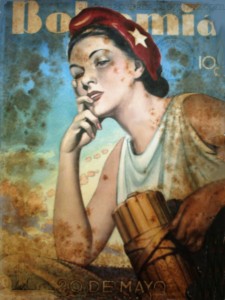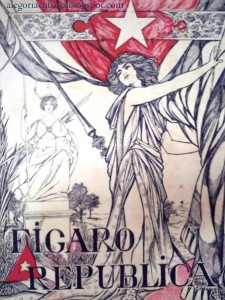REVISTAS CUBANAS: Memorias. Sus portadas y significado.
La imagen de Cuba en los años 50′
Bohemia, 1947
Un poco antes de finalizar la década del 40′, en 1947, en la portada de Bohemia asoma una figura exclusiva que conjuga, por primera vez en la lámina alegórica, dos técnicas: la fotografía y el dibujo.
El diseño libre se fusiona con la instantánea fotográfica y se obtiene una imagen que está más cercana a los cánones estilísticos de la década posterior.
Esta alegoría insiste en el uso de vestimentas clásicas, el gorro frigio y el haz de varillas proveniente del escudo. Similar en el gesto a la portada de 1939, la reflexión apática se percibe en su mirada.
La República en harapos
Carteles, agosto de 1933, alegoría de Cuba
En agosto de 1933, en la portada de Carteles, la República pierde su jovialidad. Tras el derrocamiento de Machado, la nación se representa en harapos, arruinada, pero con el puño levantado.
La fuerza del impacto visual radica en la simplicidad de sus elementos. El fondo de la bandera, el desgarramiento de las vestiduras de la República que renace, que cierra con fuerza su puño y lo alza, aluden a la resurrección y a la oportunidad de reconstruir lo perdido, una vez vencido el tirano.
Esta portada concuerda con el ánimo general de la época, puesto que se relaciona con las portadas alegóricas de Bohemia de este año, enfocadas también en representar el fin del Machadato y la necesidad de un nuevo comienzo.
El Fígaro el 20 de mayo de 1902
El Fígaro, 20 de mayo de 1902
El 20 de mayo de 1902 se establece el gobierno constitucional y El Fígaro hace eco del acontecimiento. El número de mayo se distingue en su superficie por una estructura escenográfica: una joven corre un telón con la bandera nacional y deja al descubierto una efigie escultórica de la victoria.
La escultura sedente porta una pica, en alusión al éxito militar; una tabla que simula la Constitución; la estrella solitaria y una corona de laurel sobre su cabeza, atributo de la victoria.
La leyenda Fígaro República no da margen a la duda: es una alegoría de la República de Cuba.
Las jóvenes vestidas con túnicas romanas y los atributos simbólicos de la Victoria se utilizan para subrayar el éxito y la institucionalización de un estado democrático, moderno y occidental, patriótico por demás (nótese la redundancia de la bandera en el telón y a los pies de la figura escultórica) que inaugura un ciclo inédito en la historia.
Con esta imagen se estrena una nueva puesta en escena de la nación, que se define a sí misma mediante el procedimiento alegórico.
Alegorias/Mazorra/InternetPhotos/ww.thecubanhistory.com
CUBAN MAGAZINES: Memoirs. Its covers and meanings.
The Cuban History, Hollywood.
Arnoldo Varona, Editor
Puesta de sol en Varadero, Cuba.
Foto por David Emmanuel Elizondo, Caccamese Fabio, Kenneth EL Heat Garner and Sonia Nizza.

CUBAN MAGAZINES : Memoirs. Its covers and meanings.
The image of Cuba in the 50’s
Bohemia, 1947
Shortly before the end of the 40s ‘ , in 1947 , on the cover of Bohemia hovering figure that combines an exclusive , first in the allegorical film , two techniques : photography and drawing.
Free design merges with snapshot and a photographic image that is closest to the stylistic canons of the decade is obtained.
This allegory insists on the use of classic clothing, the Phrygian cap and the bundle of rods from the shield. Similar in gesture to Home 1939 apathetic reflection is seen in her eyes.
The Republic in rags
Posters , August 1933 , Allegory of Cuba
In August 1933 , on the cover of posters, the Republic lost his joviality . After the overthrow of Machado , the nation is in tatters , ruined, but with raised fist.
The visual impact strength lies in the simplicity of its elements. The background of the flag, the tearing of the garments of the Republic Reborn , closing his fist hard and upward , alluding to the resurrection and the opportunity to rebuild what was lost , once defeated the tyrant .
This cover matches the general mood of the time , as it relates to the allegorical covers Bohemia this year, also focused on representing the end of Machadato and the need for a new beginning.
Figaro on May 20, 1902
The Figaro, May 20, 1902
The May 20, 1902 the constitutional government and the Figaro is set echoes the event. The May issue stands on its surface by a spectacular structure: a young woman runs a curtain with national flag and reveals a sculptural effigy of victory.
The seated sculpture carries a pike , alluding to military success , a table that simulates the Constitution , the Lone Star and a laurel wreath on his head, attribute the victory.
The Figaro Republic legend gives no room for doubt : it is an allegory of the Republic of Cuba .
Young dressed in Roman robes and symbolic attributes of Victoria are used to highlight the success and institutionalization of a democratic , modern and western , patriotic status in other (notice the redundancy in the backdrop banner at the foot of the figure sculpture ) that opens an unprecedented cycle in history.
With this new staging of the nation that defines itself by the allegorical method opens .
Allegories / Mazorra / InternetPhotos / ww.thecubanhistory.com
CUBAN MAGAZINES : Memoirs . Its covers and meanings .
The Cuban History , Hollywood.
Arnoldo Varona , Editor





